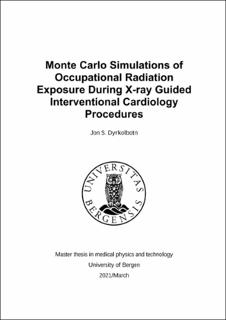| dc.description.abstract | X-ray imaging is widely used as a diagnostic tool in many medical fields. Medical personnel can often reduce their exposure with distance and sufficient radiation protection, as they do not have to be close to the radiation field. Invasive cardiologists cannot take advantage of this. They must work close to the radiation field during multiple sessions throughout their career, exposing themselves to scatter radiation. Radiation shielding and lead clothing is used to reduce their dose. Monte Carlo (MC) simulations are the standard for calculating dose. FLUKA is a general-purpose tool that use the MC method to simulate particle transport and interactions with matter. These features make the program able to simulate and measure, amongst other quantities, absorbed dose and fluence. The aim of this study is to evaluate the feasibility of using MC simulations through FLUKA to calculate and evaluate the dose given to the interventional cardiologists (operator) for different radiation shielding. An operation room at Haukeland University Hospital (HUS) used for interventional cardiac procedures was recreated in FLUKA and used during the simulations. Data from real procedures at the operation room was attained to recreate a realistic energy spectrum, beam placement, and spread of the radiation source. The different radiation shielding had a definitive impact on the dose given to the operator according to the simulations. The defining feature of the setups was the inclusion of gaps between the in the different layers of shielding or the floor. Such gaps did result in almost ten times higher dose at some parts in the operator. A significant reduction of the dose was also observed when placing a lead blanket over the patient’s body, outside the radiation field. In conclusion, FLUKA is viable tool in assessing the relative effect of different shielding setups and how they relate to the dose given to the operator. It can recreate energy spectrums and beam geometries based on real data. To reduce the dose given to the operator, the focus should be to avoid gaps between shielding components or to add a lead blanket over the patient. | |
